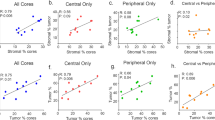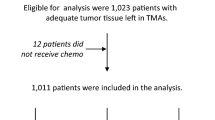Abstract
The aims of this study were to examine the significance of CD3+ cells in patients with epithelial ovarian cancer and to determine their influence on the disease in relation to their location within tumours. A 157-core tissue-microarray constructed from primary ovarian cancer patients treated at Nottingham-University-Hospitals (2000–2007) was stained for the T-cell marker CD3. The number of CD3+ cells in direct contact with tumour cells was counted per tumour area. These were considered as “intra-tumoural T-cells (ITTC)”. Cores were divided into CD3 ‘high’ or ‘low’ density tumours. “Stromal T-cells (STC)” were assigned as ‘positive’ or ‘negative’. The study population had a median follow-up time of 36-months (0–75). The number of ITTC counted in tumour cores ranged between 0 and 184/mm2. 90-tumours-(57%) were found to be in the “low-density” rubric, while 56-(36%) were of a “high-density” T-cell population. STC were found in 118-cores-(75%)-compared to 22-cores-(14%)-negative cores. Higher number of ITTC correlated with lower-grade-(p = 0.045), tumour-type-(p = 0.034), and longer-median-survival-times (57-versus 37-months for high-and low-ITTC densities, respectively, p = 0.038). This relationship was reversed when tumours were infiltrated by CD3+ cells in the stroma, predicting worse-survival (Log-rank-test, p = 0.028). Combining ITTC with STC produced an interesting pattern where the ITTC-low/STC + ve had the worst prognosis (p = 0.003). Infiltration of ovarian cancer by T-cells can influence its prognosis depending on the location of these cells (intra-tumoural-versus-stromal). The former predicts improved survival, while the latter is probably contributing to tumour progression and, in turn, worse survival.




Similar content being viewed by others
References
CRUK (2009) UK Ovarian Cancer statistics [cited 2009 20/05/2009]; Available from:
Hussein MR, Hassan HI (2006) Analysis of the mononuclear inflammatory cell infiltrate in the normal breast, benign proliferative breast disease, in situ and infiltrating ductal breast carcinomas: preliminary observations. J Clin Pathol 59(9):972–977
Sato E, Olson SH, Ahn J, Bundy B, Nishikawa H, Qian F et al (2005) Intraepithelial CD8+ tumor-infiltrating lymphocytes and a high CD8+/regulatory T cell ratio are associated with favorable prognosis in ovarian cancer. Proc Natl Acad Sci USA 102(51):18538–18543
Shah CA, Allison KH, Garcia RL, Gray HJ, Goff BA, Swisher EM (2008) Intratumoral T cells, tumor-associated macrophages, and regulatory T cells: association with p53 mutations, circulating tumor DNA and survival in women with ovarian cancer. Gynecol Oncol 109(2):215–219
Zhang L, Conejo-Garcia JR, Katsaros D, Gimotty PA, Massobrio M, Regnani G et al (2003) Intratumoral T cells, recurrence, and survival in epithelial ovarian cancer. N Engl J Med 348(3):203–213
Echchakir H, Vergnon I, Dorothee G, Grunenwald D, Chouaib S, Mami-Chouaib F (2000) Evidence for in situ expansion of diverse antitumor-specific cytotoxic T lymphocyte clones in a human large cell carcinoma of the lung. Int Immunol 12(4):537–546
Halapi E, Yamamoto Y, Juhlin C, Jeddi-Tehrani M, Grunewald J, Andersson R et al (1993) Restricted T cell receptor V-beta and J-beta usage in T cells from interleukin-2-cultured lymphocytes of ovarian and renal carcinomas. Cancer Immunol Immunother 36(3):191–197
Balkwill F (2009) Tumour necrosis factor and cancer. Nat Rev 9(5):361–371
Hagemann T, Balkwill F, Lawrence T (2007) Inflammation and cancer: a double-edged sword. Canc Cell 12(4):300–301
Kulbe H, Thompson R, Wilson JL, Robinson S, Hagemann T, Fatah R et al (2007) The inflammatory cytokine tumor necrosis factor-alpha generates an autocrine tumor-promoting network in epithelial ovarian cancer cells. Cancer Res 67(2):585–592
Dunn GP, Bruce AT, Ikeda H, Old LJ, Schreiber RD (2002) Cancer immunoediting: from immunosurveillance to tumor escape. Nat Immunol 3(11):991–998
Dougan M, Dranoff G (2009) The immune response to tumors. Current protocols in immunology. In: Coligan JE et al (eds) Chapter 20:Unit 20 11.
Stewart TJ, Abrams SI (2008) How tumours escape mass destruction. Oncogene. 27(45):5894–5903
Halpern AC, Schuchter LM (1997) Prognostic models in melanoma. Semin Oncol 24(1 Suppl 4):S2–S7
Marrogi AJ, Munshi A, Merogi AJ, Ohadike Y, El-Habashi A, Marrogi OL et al (1997) Study of tumor infiltrating lymphocytes and transforming growth factor-beta as prognostic factors in breast carcinoma. Int J Cancer 74(5):492–501
Naito Y, Saito K, Shiiba K, Ohuchi A, Saigenji K, Nagura H et al (1998) CD8+ T cells infiltrated within cancer cell nests as a prognostic factor in human colorectal cancer. Cancer Res 58(16):3491–3494
Nakano O, Sato M, Naito Y, Suzuki K, Orikasa S, Aizawa M et al (2001) Proliferative activity of intratumoral CD8(+) T-lymphocytes as a prognostic factor in human renal cell carcinoma: clinicopathologic demonstration of antitumor immunity. Cancer Res 61(13):5132–5136
Vesalainen S, Lipponen P, Talja M, Syrjanen K (1994) Histological grade, perineural infiltration, tumour-infiltrating lymphocytes and apoptosis as determinants of long-term prognosis in prostatic adenocarcinoma. Eur J Cancer 30A(12):1797–1803
Raspollini MR, Castiglione F, Rossi Degl'innocenti D, Amunni G, Villanucci A, Garbini F et al (2005) Tumour-infiltrating gamma/delta T-lymphocytes are correlated with a brief disease-free interval in advanced ovarian serous carcinoma. Ann Oncol 16(4):590–596
Dadmarz RD, Ordoubadi A, Mixon A, Thompson CO, Barracchini KC, Hijazi YM et al (1996) Tumor-infiltrating lymphocytes from human ovarian cancer patients recognize autologous tumor in an MHC class II-restricted fashion. Canc J Sci Am 2(5):263–272
Kooi S, Zhang HZ, Patenia R, Edwards CL, Platsoucas CD, Freedman RS (1996) HLA class I expression on human ovarian carcinoma cells correlates with T-cell infiltration in vivo and T-cell expansion in vitro in low concentrations of recombinant interleukin-2. Cell Immunol 174(2):116–128
Loercher AE, Nash MA, Kavanagh JJ, Platsoucas CD, Freedman RS (1999) Identification of an IL-10-producing HLA-DR-negative monocyte subset in the malignant ascites of patients with ovarian carcinoma that inhibits cytokine protein expression and proliferation of autologous T cells. J Immunol. 163(11):6251–6260
Nakashima M, Sonoda K, Watanabe T (1999) Inhibition of cell growth and induction of apoptotic cell death by the human tumor-associated antigen RCAS1. Nat Med 5(8):938–942
Rabinowich H, Reichert TE, Kashii Y, Gastman BR, Bell MC, Whiteside TL (1998) Lymphocyte apoptosis induced by Fas ligand- expressing ovarian carcinoma cells. Implications for altered expression of T cell receptor in tumor-associated lymphocytes. J Clin Invest 101(11):2579–2588
Santin AD, Bellone S, Ravaggi A, Pecorelli S, Cannon MJ, Parham GP (2000) Induction of ovarian tumor-specific CD8+ cytotoxic T lymphocytes by acid-eluted peptide-pulsed autologous dendritic cells. Obstet Gynecol 96(3):422–430
Woo EY, Chu CS, Goletz TJ, Schlienger K, Yeh H, Coukos G et al (2001) Regulatory CD4(+)CD25(+) T cells in tumors from patients with early-stage non-small cell lung cancer and late-stage ovarian cancer. Cancer Res 61(12):4766–4772
Mantovani A, Allavena P, Sica A, Balkwill F (2008) Cancer-related inflammation. Nature 454(7203):436–444
Nelson BH (2008) The impact of T-cell immunity on ovarian cancer outcomes. Immunol Rev 222:101–116
Hayashi K, Yonamine K, Masuko-Hongo K, Iida T, Yamamoto K, Nishioka K et al (1999) Clonal expansion of T cells that are specific for autologous ovarian tumor among tumor-infiltrating T cells in humans. Gynecol Oncol 74(1):86–92
Negus RP, Stamp GW, Hadley J, Balkwill FR (1997) Quantitative assessment of the leukocyte infiltrate in ovarian cancer and its relationship to the expression of C-C chemokines. Am J Pathol 150(5):1723–1734
Santin AD, Hermonat PL, Ravaggi A, Bellone S, Roman JJ, Smith CV et al (2001) Phenotypic and functional analysis of tumor-infiltrating lymphocytes compared with tumor-associated lymphocytes from ascitic fluid and peripheral blood lymphocytes in patients with advanced ovarian cancer. Gynecol Obstet Invest 51(4):254–261
Tomsova M, Melichar B, Sedlakova I, Steiner I (2008) Prognostic significance of CD3+ tumor-infiltrating lymphocytes in ovarian carcinoma. Gynecol Oncol 108(2):415–420
Rolland P, Spendlove I, Madjid Z, Rakha EA, Patel P, Ellis IO et al (2007) The p53 positive Bcl-2 negative phenotype is an independent marker of prognosis in breast cancer. Int J Cancer 120(6):1311–1317
Vicari AP, Treilleux I, Lebecque S (2004) Regulation of the trafficking of tumour-infiltrating dendritic cells by chemokines. Semin Cancer Biol 14(3):161–169
Curiel TJ, Coukos G, Zou L, Alvarez X, Cheng P, Mottram P et al (2004) Specific recruitment of regulatory T cells in ovarian carcinoma fosters immune privilege and predicts reduced survival. Nat Med 10(9):942–949
Bernsen MR, Diepstra JH, van Mil P, Punt CJ, Figdor CG, van Muijen GN et al (2004) Presence and localization of T-cell subsets in relation to melanocyte differentiation antigen expression and tumour regression as assessed by immunohistochemistry and molecular analysis of microdissected T cells. J Pathol 202(1):70–79
Haas M, Dimmler A, Hohenberger W, Grabenbauer GG, Niedobitek G, Distel LV (2009) Stromal regulatory T-cells are associated with a favourable prognosis in gastric cancer of the cardia. BMC Gastroenterol. 9:65
Menetrier-Caux C, Gobert M, Caux C (2009) Differences in tumor regulatory T-cell localization and activation status impact patient outcome. Canc Res
Mizukami Y, Kono K, Kawaguchi Y, Akaike H, Kamimura K, Sugai H et al (2008) Localisation pattern of Foxp3+ regulatory T cells is associated with clinical behaviour in gastric cancer. Br J Cancer 98(1):148–153
Leffers N, Gooden MJ, de Jong RA, Hoogeboom BN, ten Hoor KA, Hollema H et al (2009) Prognostic significance of tumor-infiltrating T-lymphocytes in primary and metastatic lesions of advanced stage ovarian cancer. Cancer Immunol Immunother 58(3):449–459
Acknowledgement
We would like to thank Nottingham University Hospitals Charitable Research Fund for partially funding this work.
Author information
Authors and Affiliations
Corresponding author
Rights and permissions
About this article
Cite this article
Al-Attar, A., Shehata, M., Durrant, L. et al. T Cell Density and Location Can Influence the Prognosis of Ovarian Cancer. Pathol. Oncol. Res. 16, 361–370 (2010). https://doi.org/10.1007/s12253-009-9230-5
Received:
Accepted:
Published:
Issue Date:
DOI: https://doi.org/10.1007/s12253-009-9230-5




